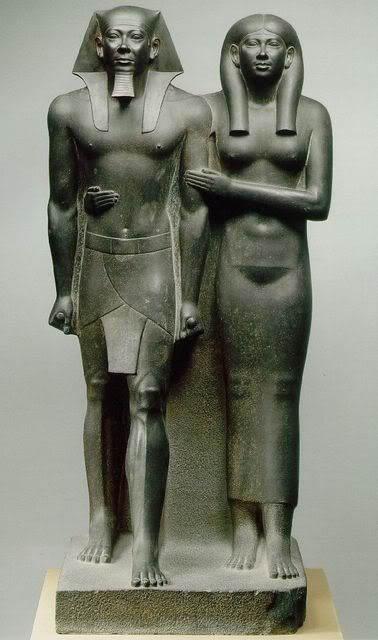The values and symbolisms of art have greatly changed over vast centuries. Especially when looking at art from the BC times and those from more modern dates, there are huge variations in the reasons in which works were made and what it stood for. I found it quite interesting when I noticed the changes that resided in the sculptures of these different time periods. Not only were the cultures in which they were made from completely different, but the values that were put into them were also unique as well.

The "Woman Of Willendorf" is a well known sculpture from the Neolithic times, and was used as a fertility idol to ensure the reproduction of the people that used it. In those times, sculptures such as the Woman Of Willendorf were believed to possess magic and powers that would be passed onto the person by touching it. They functioned very much like the "good luck charms" we believe in today, such as the four leaf clover.

In ancient Egypt, a major function of sculptures were made as vessels for "Ka", which is the spirit that inhabited the body. The Egyptians believed that while you lived your living body was the vessel for Ka and therefore must seek another vessel once you die. Therefore, many of these sculptures were still connected to the stone in which they were carved from, (which is also known as "high relief") and being connected to the stone was a representation that it functioned as a containment for the Ka. Ka sculptures also varied among different classes. For example, the Pharaoh's Ka statue would be much more rigid and stiff, while that of a lower class person would be more relaxed in pose. Altogether, it is seen that ancient art revolved heavily around beliefs in unexplainable and unseen forces.

As the world progressed to Greek and Roman times, sculpture was used as a means of documenting life and the human became the main focus of art. "Ara Pacis" as pictured above is a monument made during the time in which Augustus was a great emperor of Rome. The sculpture is a documentary of one of his great victories. Greek sculpture at first contained many elements from the Egyptian Ka statues but evolved with the addition of high details and more realistic features. The Romans contributed extreme realism and the use of "busts".

As time continued to progress, religion soon became a main focus of life. The belief of God in these times was much like the belief in magical forces in Neolithic times. Works like the one pictured above (Andrea Pisano's "Baptism of Christ, Life of John the Baptist) depicted an important biblical moment in both a beautiful and simple way in which everyone could understand.

Bernini's "David" shows us how sculpture has changed over the years from what used to be stiff statues to ones of movement an expression. Textures have also been improved; clothing used to be flat and heavy, and now clothing had folds and lifts that gave it an airy, light look to it.

In more modern times, sculpture starts to become highly abstract, causing the viewer to think more heavily about the influences upon him/herself rather than giving a direct message. The image above is made by Eva Hesse, which to an unimaginative person would make no sense since it is simply a jumble of rope, but to those with a creative mind could interpret it as something completely different.

New and unfamiliar materials are also much more common in modern art, along with completely new ways in which to use them. Seen above is a work made of Earth itself, which was made by Robert Smithson.

Modern art seems quite strange at times but is still just as interesting. This piece by Meret Oppenheim brings a completely new twist in the way we see and feel about an item we probably never gave much thought about before; imagine how strange and awkward it would feel to drink out of a cup made completely of fur?
Art history altogether helps us understand the changes in the values of people over time and what art meant to them, what they used art for, and what meant the most to them in life.
No comments:
Post a Comment